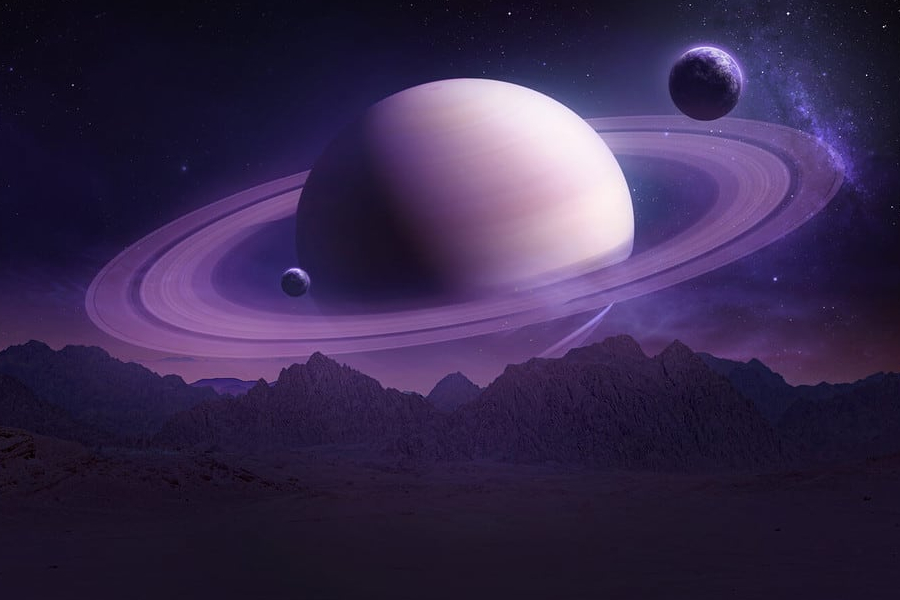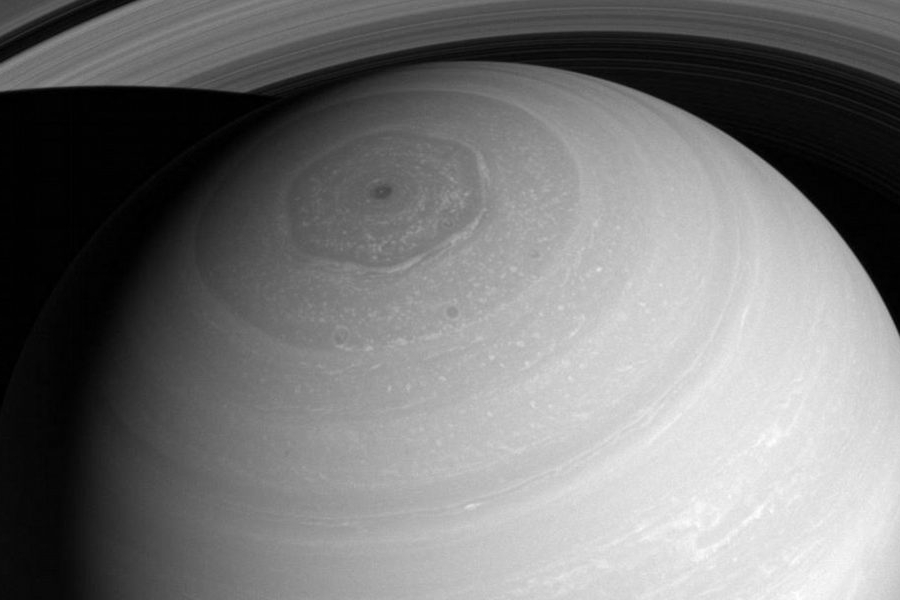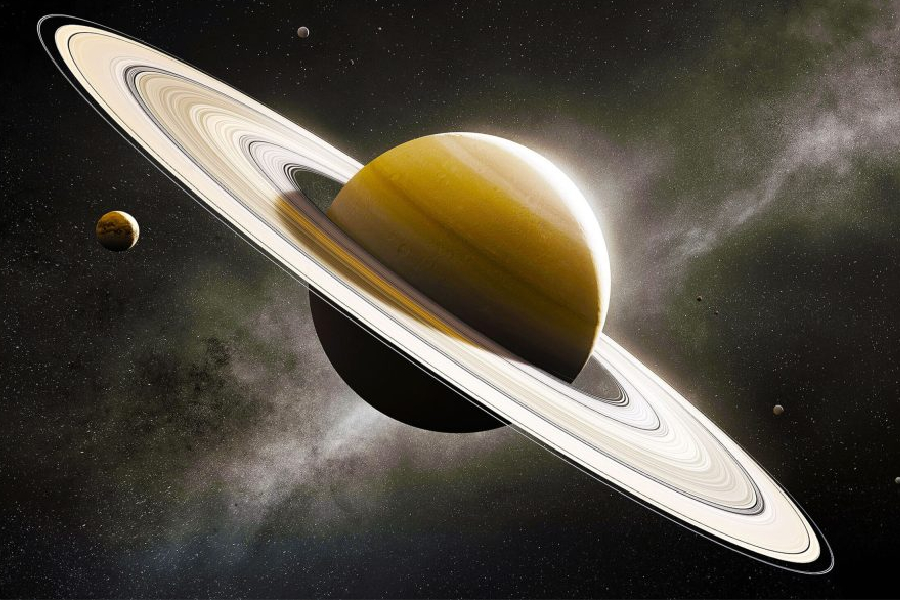Saturn has captivated astronomers and sky-watchers for centuries with its dazzling rings and golden complexion. This gas-giant world, the sixth planet from the Sun, hides many mysteries beneath its cloudy exterior.
But what other secrets does Saturn hold? What stories do its rings and moons have to tell? In this article, we will explore some of Saturn characteristics and discuss key facts about its atmosphere, magnetic field, interior structure, and awe-inspiring rings.
From its strange hexagonal storm to its less-known moons, we will uncover some mysteries surrounding this celestial body. We will also look at Saturn’s place in the solar system and how it compares to neighboring planets.
Join us on a journey to get acquainted with the sixth rock from the Sun!
About Saturn Characteristics
Saturn boasts several distinctive characteristics. Perhaps the most iconic is its extensive ring system, composed of ice and rock particles, making it the most prominent among all planets. They extend thousands of miles from the planet and contain particles ranging in size from tiny grains to giant boulders.
However, there is much more to Saturn than just its rings. A dynamic interior structure and turbulent atmosphere lie beneath the cloud tops, whipped to incredible speeds by Saturn’s raging winds. It is also home to a magnetic field that aligns with its rotational axis, unlike any other planet. With over 150 moons and moonlets, Saturn possesses its system of satellites to explore.
Also, Saturn is classified as a gas giant, predominantly composed of hydrogen and helium. It also hosts a multitude of moons, with Titan being the largest and most intriguing due to its thick atmosphere. Notably, Saturn stands out as the least dense planet in our solar system, owing to its primarily gaseous composition.

Physical Characteristics of Saturn
Size, mass, and position in the solar system
Saturn is the sixth planet from the Sun and the second largest planet in our solar system after Jupiter. At about 120,536 km (74,898 miles) wide, it’s over nine times wider than our planet Earth.
You could fit almost ten Earths across its diameter. Despite its massive size, Saturn is actually the least dense planet, with an average density less than water. This giant world tips the scales at 95 times the mass of Earth.
Furthermore, Saturn cruises around the Sun at an average distance of about 1.4 billion km –roughly nine and a half times farther than Earth’s orbit. It takes Saturn nearly 30 Earth years just to complete one lap around the Sun. With that kind of long, slow track, Saturn’s seasons last over seven years each.
Striking ring system
One of Saturn’s most iconic features is its extensive ring system, which gives the planet its signature appearance. Made of billions of ice particles and bits of rock, these rings orbit Saturn in an astonishingly thin layer, extending up to 175,000 miles from the planet.
The rings look solid from afar, but they are composed of separate ringlets with gaps between them. The largest gap, the Cassini Division, is about 2,920 miles wide. The main rings have names like the C and B, but don’t let the simple labels fool you. Each ring has its unique properties, and some are braided or twisted in shape.
Furthermore, Saturn’s rings are divided into several zones with different names and characteristics. The innermost is the D ring, followed by the C, B, Cassini Division, A, and outer F rings. The B ring is the brightest and most dense area.
Between the B ring and A ring is the Cassini Division, which appears from Earth as a gap in the rings but has some thinner ringlets. The farthest ring, the F ring, has a twisted, braided appearance. The particles that make up Saturn’s rings orbit the planet at different speeds based on their distance from the planet. Closer ring particles orbit faster than those farther out, following Kepler’s laws of planetary motion.
Additionally, the rings are likely debris remaining from comets, asteroids, or shattered moons that came too close to Saturn. While the rings may appear old, they are relatively young, likely forming less than 100 million years ago. Talk about a cosmic wonder!
Saturn’s Atmosphere: A Turbulent Mix
Plunging into the cloud layers reveals that Saturn’s atmosphere consists mainly of hydrogen and helium, giving it that light, airy composition. But traces of other compounds like methane, ammonia, and ethane are also present, influencing the clouds’ colors and chemistry. Deeper down lies a liquid metallic hydrogen extending thousands of miles toward Saturn’s core.
As for the weather, buckle up because Saturn gets wild. Fierce winds rage through the atmosphere at speeds over 1100 mph—more than four times the terminal velocity of a tornado on Earth.
These runaway gusts whip around the planet significantly faster than Saturn’s rotation. One highlight is the bizarre hexagonal vortex swirling around Saturn’s north pole, complete with a hurricane-like eye at its center.
And get this – Saturn has the hottest summer temperatures in the solar system outside the Sun, with its equator hitting a sweltering 80 degrees Fahrenheit despite being so ridiculously far from the Sun’s heat. Maybe that’s why the winds are so extreme.
Saturn’s Moons
Saturn has 62 confirmed moons and another 29 awaiting official status, making it the planet with the most known moons. These moons come in huge sizes, from the giant Titan to miniscule moonlets just a mile wide. Some of Saturn’s most fascinating moons include:
- Titan – the second largest moon in the solar system with a thick nitrogen atmosphere.
- Enceladus – home to a global ocean beneath its icy crust.
- Iapetus – has one bright and one dark hemisphere.
- Hyperion – oddly shaped with a sponge-like appearance.
- Mimas – sports an enormous crater named Herschel that resembles the Death Star.
The moons provide knowledge about Saturn’s history and origins. Each moon has its secrets to unveil in our ongoing exploration of the Saturnian system.
Rotation and Day-Night Cycle of Saturn
Saturn takes about 10.8 hours to complete one rotation on its axis. This means a single Saturnian day is just over half as long as an Earth day at 24 hours. However, Saturn’s extreme axial tilt of 26.73 degrees gives it much longer seasons than Earth. On Earth, each season lasts three months. But Saturn’s seasons each persist for over seven years due to its 29 Earth-year orbit around the Sun.
This means Saturn experiences unusually long periods of constant daylight or darkness in the summer and winter of each pole. During summer at the North Pole, the Sun shines continuously for over seven years without setting.
The South Pole then has a long night that lasts for seven years of Saturn winter. Saturn’s equinoxes occur midway through these long seasons, bringing equal day and night, much like on Earth.

The Hexagonal Storm
One of Saturn’s most intriguing features is the persistent hexagonal cloud pattern encircling its north pole. This giant hurricane-like vortex has six straight sides and a circular eye at its center. The entire structure rotates counter-clockwise like a cyclone, measuring about 25,000 km across, wider than two Earths.
The origins of Saturn’s hexagon remain a mystery. The six-sided shape may be caused by Saturn’s unique wind currents and jet streams interacting with each other in the turbulent polar atmosphere.
Similar shapes have been reproduced in laboratory simulations of planetary atmospheres. Over almost four decades of observations, the structure has persisted despite changing seasons on Saturn. This makes it a long-lived anomaly that continues to captivate scientists.
Gas Giant Classification
Saturn belongs to a unique group of planets known as gas giants. But what exactly earns it this title? Saturn’s gas giant status can be attributed to its colossal size and composition.
Like its fellow gas giants, Jupiter, Uranus, and Neptune, Saturn is predominantly made up of lighter elements, mainly hydrogen and helium. These elements dominate its internal structure, forming a vast gaseous envelope around a likely solid core.
One defining characteristic of gas giants is their lack of a solid surface, unlike rocky planets like Earth or Mars. On Saturn, the gaseous atmosphere extends deep into the planet, gradually becoming denser and transitioning into metallic hydrogen at greater depths. This unique structure allows Saturn to maintain its impressive size and gravitational influence, making it a member of the elite gas giant club.
Comparing Saturn to other gas giants
Saturn is undoubtedly a remarkable gas giant, but how does it measure up against its celestial cousins – Jupiter, Uranus, and Neptune? Let’s check the gas giant family:
Jupiter
As the largest of the gas giants and indeed the entire solar system, Jupiter is a formidable force. Its powerful magnetic field and thick atmosphere features the iconic Great Red Spot, a massive storm. While Saturn’s rings are dazzling, Jupiter has a more subtle ring system.
Uranus
Uranus has a unique claim to fame – it rotates on its side. This planet’s rotational axis is almost perpendicular to its orbit around the Sun. It has a distinct bluish-green hue due to the presence of methane in its atmosphere. Uranus also has a collection of rings and a slew of intriguing moons.
Neptune
The farthest gas giant in our solar system, Neptune, is known for its stunning deep-blue color. It features powerful storms and the most famous of them all, the Great Dark Spot. Neptune has a faint ring system and a diverse range of moons, including Triton, which orbits in a retrograde direction.
Saturn’s Exploration
Saturn has beckoned explorers from Earth, and their missions have unveiled its hidden treasures. Here are some key missions and probes that have ventured to Saturn:
- Pioneer 11 (1979) – Pioneer 11 made a historic flyby of Saturn, capturing the first close-up images of the ringed giant and its intricate ring system.
- Voyager 1 and 2 (1980 and 1981) – The Voyager spacecraft provided an even closer look, revealing the intricacies of Saturn’s rings and its family of moons. Voyager 1 also captured the iconic “Pale Blue Dot” image of Earth from the vantage point of deep space.
- Cassini-Huygens (2004-2017): The Cassini-Huygens mission was a game-changer. Cassini orbited Saturn for over a decade, offering unprecedented data on the planet, its rings, and its diverse moons. The Huygens probe even landed on Saturn’s intriguing moon, Titan.
- Future missions: Plans for future missions to Saturn continue to evolve, promising even more revelations and a deeper understanding of this captivating gas giant.

Discoveries
The missions to Saturn have delivered many discoveries. Here are some key findings that have enriched our understanding of Saturn:
- Intricate Rings – Close-up observations unveiled the intricate structure of Saturn’s rings, with ringlets, gaps, and braided patterns that continue to mystify scientists.
- Titan’s Mysteries – Titan, Saturn’s largest moon, has proven to be a world of intrigue with a thick atmosphere, lakes of liquid methane, and a potential for life.
- Enceladus’s Geysers – The moon Enceladus surprised everyone by revealing geysers of water ice erupting from its south pole, suggesting the possibility of a subsurface ocean.
- Stormy Skies – The Cassini mission captured violent storms and disturbances in Saturn’s atmosphere, furthering our understanding of planetary weather systems.
Saturn’s Scientific Significance
Scientists have a particular fascination with Saturn for several reasons:
- Planetary evolution – Saturn provides a unique window into the early history of our solar system, offering insights into the processes that shaped the planets.
- Gas giant mysteries – As a gas giant, Saturn presents an intriguing opportunity to study the behavior of planetary atmospheres, magnetic fields, and internal structures.
- Moons and their secrets – Saturn’s moon system, particularly Titan and Enceladus, holds the key to understanding the potential habitability of icy worlds and the processes at work on these celestial bodies.
Implications for planetary science and beyond
Saturn’s significance transcends its boundaries, reaching into the realms of planetary science, astrobiology, and solar system dynamics. Delving into the mysteries of Saturn aids our comprehension of the formation and evolution of planets, shedding light on the processes that shaped not only Saturn but also Earth and the other celestial bodies in our solar system.
Furthermore, with its potential for organic chemistry and even life, the enigmatic moon Titan offers tantalizing clues about the conditions that might support life elsewhere within our cosmic neighborhood.
Observations of Saturn and its dynamic interactions with its diverse moons contribute to our understanding of the intricate cosmic dance governing our solar system’s evolution.
Frequently Asked Questions
Is Saturn the only planet with rings?
No, the other gas giants – Jupiter, Uranus, and Neptune – also have ring systems. However, Saturn’s rings are by far the most extensive and visible, spanning up to 175,000 miles from the planet. The rings are also a unique attribute that helps distinguish Saturn.
Why does Saturn intrigue people?
Saturn captivates people for many reasons. Its elegant rings are a sight to behold and make Saturn iconic. The planet also has an intriguing collection of moons, atmospheric mysteries like the northern hexagonal storm, and the fastest winds in the Solar System. Saturn simply has many fascinating qualities that capture the imagination.
What are the key physical differences between Saturn and Jupiter?
Though both are gas giants, Jupiter and Saturn have some notable physical differences:
- Jupiter is larger and more massive overall than Saturn.
- Jupiter has thicker and more turbulent cloud bands in its atmosphere compared to Saturn’s more delicate stripes.
- Saturn has extensive rings, while Jupiter has faint rings not readily visible from Earth.
- Saturn rotates faster than Jupiter, with a day of 10.8 hours versus Jupiter’s 10 hours.
- Jupiter radiates more internal heat than Saturn, with temperatures around 20,000 °F compared to Saturn’s 11,000 °F.
So, while the two share similarities as gas giants, details like size, rings, and atmosphere set them uniquely apart.
Conclusion
Saturn stands out as a captivating wonder in our solar system, from its striking rings to surprising winds. This gas giant planet is best known for its extensive ring system, made of billions of particles orbiting in intricate patterns. But there is more to Saturn than just rings.
The planet also impresses with its mammoth size, over nine times wider than Earth. A deeper investigation reveals Saturn’s turbulence, from winds blasting over 1000 mph in its hydrogen-rich atmosphere to oddities like the hexagonal polar vortex.
Saturn again astonishes with over 60 moons, harboring subsurface oceans, strange shapes, and more mysteries. While the Voyager probes offered an introductory reconnaissance, much remains undiscovered about Saturn’s properties and origins.
So, we have revealed all the fascinating Saturn characteristics, from its physical features to weather patterns. Just as the rings encircle Saturn, mysteries also continue to surround this celestial showstopper, awaiting future study and admiration.
